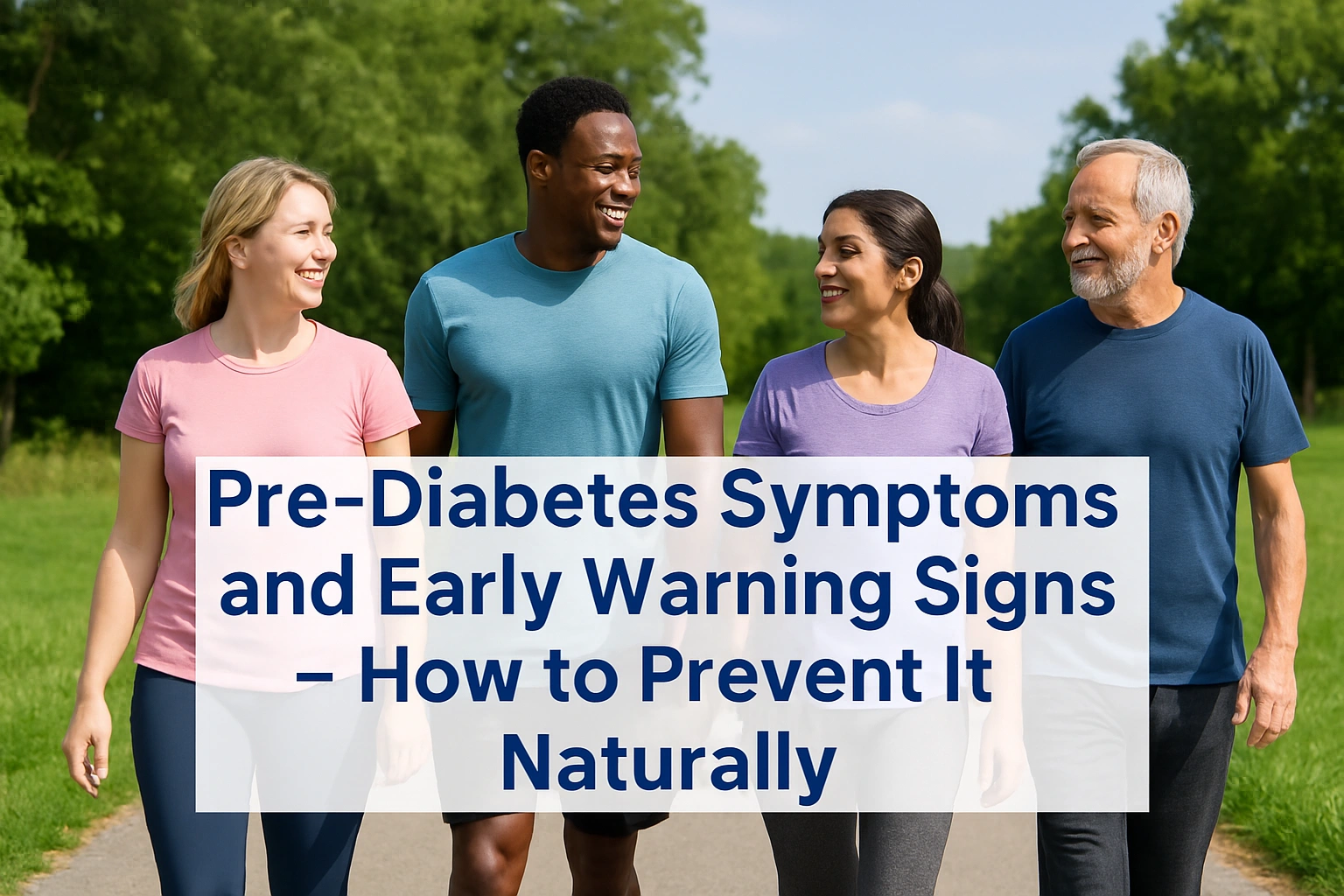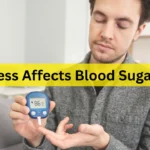Ever wondered if your body is quietly warning you about diabetes—before it even starts? Pre-diabetes is that early red flag. It happens when your blood sugar levels are higher than normal, but not high enough to be diagnosed as type 2 diabetes. The tricky part? You might feel completely fine, and that’s exactly why it often goes unnoticed.
But here’s the thing: pre-diabetes doesn’t mean you’re guaranteed to get type 2 diabetes. In fact, it’s your best window of opportunity to turn things around—naturally. With the right lifestyle changes, many people can stop it in its tracks or even reverse it completely.
In this article, we’ll uncover the early warning signs of pre-diabetes, explain what causes it, and walk you through simple, natural ways to prevent it from turning into something more serious. If you’re ready to take control of your health, keep reading—your future self will thank you.
What Is Pre-Diabetes?
Pre-diabetes is like a yellow light at a traffic signal—it’s not a full stop, but it’s a warning to slow down and take action. It means your blood sugar is higher than normal, but not high enough to be diagnosed as type 2 diabetes.
According to the CDC, more than 1 in 3 adults have pre-diabetes—and most don’t even know it. That’s why awareness is key.
At this stage, your body is starting to struggle with how it handles sugar (glucose). Normally, a hormone called insulin moves sugar from your blood into your cells. But in pre-diabetes:
- Your body becomes resistant to insulin, or
- Not enough insulin is being produced.
As a result, sugar builds up in your bloodstream instead of fueling your cells.
The tricky part? There are usually no obvious symptoms. That’s why pre-diabetes often goes undetected for years.

But here’s the good news:
Pre-diabetes can be reversed. With smart changes to your diet, activity, sleep, and daily habits, you can bring your blood sugar back to a healthy level—and prevent type 2 diabetes before it starts.
Early Signs and Symptoms of Pre-Diabetes
Can your body give you early signs of pre-diabetes—even if you feel totally fine? In many cases, yes. The tricky part is, most people don’t notice them until it’s too late.
In fact, over 80% of people with pre-diabetes don’t know they have it. That’s because symptoms are often subtle—or completely silent.
Still, there are a few early warning signs your body might be giving you:
- Unusual fatigue – Feeling more tired than usual, even with enough sleep? Blood sugar spikes and crashes can drain your energy.
- Increased thirst – A higher-than-normal blood sugar level can make you feel constantly thirsty.
- Frequent urination – Especially noticeable at night.
- Blurred vision – Changes in fluid levels can affect your eyes.
- Slow-healing wounds – High sugar levels can affect your body’s ability to repair itself.
- Dark patches of skin – Particularly around the neck, armpits, or groin. This condition is called acanthosis nigricans and is often linked to insulin resistance.
- Tingling or numbness – Especially in the hands and feet, which could signal nerve involvement.
Even one of these signs is worth talking to your doctor about, especially if you have risk factors like being overweight, having high blood pressure, or a family history of diabetes.
Don’t ignore the whispers your body is sending. Catching pre-diabetes early gives you the power to reverse it—before it becomes type 2 diabetes.
What Causes Pre-Diabetes (and Who’s Most at Risk)?
Why does pre-diabetes happen in the first place? It usually starts when your body stops responding properly to insulin—a condition called insulin resistance.
Insulin is a hormone that helps move sugar (glucose) from your bloodstream into your cells, where it’s used for energy. When your cells resist insulin, sugar builds up in your blood instead of being absorbed. Over time, this leads to higher blood sugar levels—and eventually, pre-diabetes.
But what causes insulin resistance? Often, it’s a mix of genetics and lifestyle habits.
Major Risk Factors for Pre-Diabetes
- Being overweight or obese, especially with belly fat
- Lack of physical activity or a sedentary lifestyle
- Unhealthy eating habits, including a high intake of sugar and processed foods
- Family history of type 2 diabetes
- Age 35 or older
- High blood pressure or abnormal cholesterol levels
- History of gestational diabetes during pregnancy
- Polycystic ovary syndrome (PCOS) in women
- Sleep issues, such as obstructive sleep apnea
- Smoking, which can increase insulin resistance
Ethnicity also plays a role. People of Asian, Black, Hispanic/Latino, Native American, or Pacific Islander descent may have a higher risk, even at a healthy weight.
While some risk factors—like age or genetics—are out of your control, many others are manageable with lifestyle changes. The key is knowing where you stand and taking action early.
What Happens If You Ignore Pre-Diabetes?
Pre-diabetes may seem harmless at first—but ignoring it can lead to serious long-term damage. Even before a full diabetes diagnosis, your body may already be under silent stress.
Over time, consistently high blood sugar levels can affect nearly every part of your body. The longer pre-diabetes goes unmanaged, the higher the risk of developing type 2 diabetes—and a list of related complications.
Potential Complications of Untreated Pre-Diabetes
- Type 2 diabetes – The most common outcome if lifestyle changes aren’t made.
- Heart disease – High blood sugar damages blood vessels, raising your risk of heart attacks and stroke.
- Kidney problems – Pre-diabetes can silently begin to affect kidney function.
- Nerve damage (neuropathy) – Especially in the feet and hands.
- Eye issues – Including blurred vision or even vision loss due to diabetic retinopathy.
- Fatty liver disease – Often linked to insulin resistance and metabolic syndrome.
- Increased risk of infections – High sugar levels can weaken your immune response.
- Slow wound healing – A sign that your circulation and immune system are being affected.
You may even experience “silent” heart attacks, meaning damage occurs without obvious warning signs. That’s why pre-diabetes is more than just a label—it’s a red flag for your entire health system.
The good news? You can still turn it around. Acting early can stop or delay these complications from ever developing.
Natural Ways to Prevent (or Reverse) Pre-Diabetes
Can you reverse pre-diabetes without medication? In many cases, yes. The key lies in making small, consistent changes to your daily routine. You don’t need a strict diet or intense workouts—just smarter choices and better habits.
Studies show that lifestyle changes can cut your risk of developing type 2 diabetes by over 50%. Even losing a modest amount of weight—just 5% to 7% of your body weight—can make a big difference.
Here’s how to get started naturally:
1. Eat Smart, Not Strict
- Focus on whole foods like vegetables, whole grains, beans, nuts, and lean proteins.
- Cut down on sugar and refined carbs (white bread, sugary drinks, pastries).
- Swap in complex carbs like brown rice, oats, and sweet potatoes.
- Don’t skip meals—especially breakfast. Balanced meals help stabilize blood sugar.
2. Move More (But Make It Fun)
- Aim for at least 30 minutes of moderate exercise, five days a week.
- Walking, cycling, swimming, dancing—even gardening—can all help.
- Take short activity breaks during the day if you sit a lot. Every bit counts!
3. Lose a Little, Gain a Lot
- Shedding just 5% of your current weight can significantly reduce your risk.
- Focus on long-term changes, not crash diets.
- Track your progress, and celebrate small wins.
4. Manage Stress and Sleep
- Chronic stress can raise blood sugar levels and lead to emotional eating.
- Try deep breathing, yoga, or short walks to manage tension.
- Aim for 7–8 hours of quality sleep each night. Poor sleep increases insulin resistance.
5. Quit Smoking
- Smoking raises blood sugar and makes insulin less effective.
- Quitting improves overall health and reduces diabetes risk.
6. Drink Water—Not Sugar
- Choose water over soda, energy drinks, or sweetened teas.
- Staying hydrated supports your metabolism and curbs sugar cravings.
These lifestyle changes don’t just help with blood sugar—they improve heart health, boost energy, and reduce your risk of other chronic conditions.
Need extra support? Ask your doctor about a diabetes prevention program or work with a registered dietitian to create a plan that fits your life.
When to See a Doctor (and What to Expect)
Not sure if you should get tested for pre-diabetes? Here’s a simple rule: if you have one or more risk factors—or you’re noticing subtle symptoms—it’s time to check in with your healthcare provider.
Pre-diabetes often flies under the radar, which is why routine screening is so important. The earlier you know, the easier it is to reverse.
When to Get Screened:
Talk to your doctor if:
- You’re 35 or older
- You’re overweight or have a high waist size
- You’re not physically active
- You have high blood pressure or high cholesterol
- You’ve had gestational diabetes
- You have a family history of type 2 diabetes
- You belong to a higher-risk ethnic group
Even if you feel fine, screening can catch rising blood sugar levels before they become a problem.
Tests That Detect Pre-Diabetes:
Your doctor might recommend:
- Fasting Blood Glucose Test – Measures your blood sugar after 8+ hours of not eating.
- A1C Test – Gives an average of your blood sugar levels over the past 2–3 months.
- Oral Glucose Tolerance Test (OGTT) – Measures how your body handles sugar over a few hours.
What do the numbers mean?
- Normal:
- Fasting glucose: under 100 mg/dL
- A1C: under 5.7%
- Pre-diabetes:
- Fasting glucose: 100–125 mg/dL
- A1C: 5.7% to 6.4%
- Diabetes:
- Fasting glucose: 126 mg/dL or higher
- A1C: 6.5% or higher
Getting tested is quick, simple, and may just save you years of future health complications.
What to Ask Your Doctor:
- What are my blood sugar levels?
- How can I lower my risk of developing type 2 diabetes?
- Should I work with a dietitian or join a diabetes prevention program?
- What lifestyle changes would make the biggest difference for me?
Remember: You don’t have to wait until something goes wrong to take control of your health. Early awareness = early action = better outcomes.
Frequently Asked Questions (FAQs)
1. Can pre-diabetes go away?
Yes. With healthy lifestyle changes, many people reverse it completely.
2. Is pre-diabetes serious?
Yes. If ignored, it can lead to type 2 diabetes and other health problems.
3. How do I know if I have pre-diabetes?
Often, you won’t feel symptoms. A simple blood test is the only way to know for sure.
4. What foods should I avoid?
Limit sugar, white bread, soda, and processed snacks.
5. What’s the best exercise for pre-diabetes?
Anything you enjoy! Walking, swimming, or cycling—30 mins a day is a great start.
6. Do I need medication for pre-diabetes?
Not always. Most people improve with diet and exercise alone.
7. How fast can I reverse it?
Many see improvements within 3 to 6 months with consistent effort.
Conclusion
Pre-diabetes doesn’t mean you’re destined to get diabetes—it’s a chance to change course before things get serious. By spotting the early signs, understanding the risks, and taking small, consistent steps, you can lower your blood sugar naturally and protect your long-term health.
| Homepage | uhmychart.org |
The best part? You don’t need drastic changes. Just start with smarter food choices, move your body daily, sleep well, and manage stress. These habits don’t just reverse pre-diabetes—they improve your energy, focus, and overall well-being.
If you’re at risk or unsure where you stand, talk to your doctor and get tested. Early detection makes all the difference.
Take charge now—your future self will thank you.






